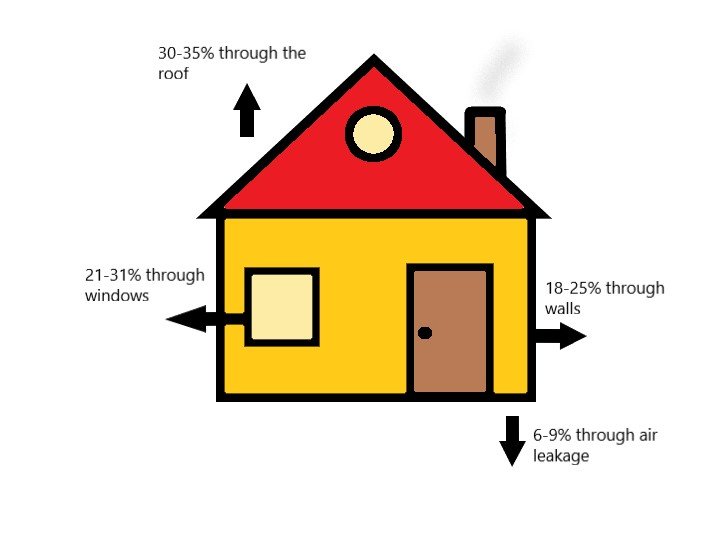The world is getting populated day by day & it’s getting richer at an even faster rate.
This rich world is transforming luxuries of the past into necessities of the present. How many car(s) or AC(s) were there in the 1980s in our society? A few, right?
The increasing number of cars or ACs is not the problem; the problem is with the amount of energy they are consuming. The difference between potential demand & the available supply of energy resources is rising rapidly.
A standard house loses heat through a variety of routes.
A large amount of energy is wasted in heating the house. Non-renewable resources, i.e. fossil fuels are in limited amount & as a responsible citizen, we all should take care of energy consumption. Although there is another non-renewable resource, nuclear energy, and a variety of renewable resources are obtainable, the technologies available have not been able to make them easily accessible & cheap.
In colder regions, a large amount of energy is used to heat the buildings and in hotter regions, there is similar consumption to cool down the buildings. These energy consumptions can be reduced by a very large extent if we tackle with the construction of buildings properly. There are a number of methods which can deal with the heat loss through the houses.
Loft insulation is a technique which means adding an insulation layer in the rooftops. This method can prevent a lot of energy loss. Some homes are built with a cavity between the inside and outside walls. If this gap is filled with an insulating material, heat will pass through far more slowly than if this space was filled with air. Since the reduction of window size is not a suitable option, energy use can be reduced by double glazing the window. This technique uses two panes of glass with a gap in the middle to act as an insulator. The gap needs to be filled with a clear material (unlike cavity wall insulation). This sealed gap is sometimes filled with an inert gas such as argon, or might simply be filled with air. The fact that the gap is sealed will improve the insulation properties of the window. Further savings could be made using triple glazing (three panes of glass), but it can be too expensive for the amount of energy being saved.
Another possible design feature is to make the roofs of homes covered up with solar panels which will supply the required energy. But there is a problem with the usage of solar energy; it is not a reliable source of energy as it is a climate & weather dependent source of energy.
There are mechanisms to procure energy from waste. People should be educated & encouraged to use such techniques. We should always turn off the electrical devices when not in use. The devices should not even be on the standby mode as they consume some energy even on that mode. Four or five devices left on standby in a household is equivalent of leaving an electric light on permanently. We should also focus on using energy-efficient devices.
It is possible to build houses that need no energy & many such houses have been built mainly in Germany & Australia.
The design features often include:
- High levels of insulation.
- Airtight construction.
- High insulation windows (using reflective glass).
- Solar panels to produce electricity and to heat water pipes.
- A ground heat exchanger to capture heat from lower levels in the ground.
- Use of heat exchanger to capture excessive heat produced by the occupants.
Organic wastes & domestic wastes can be used to produce methane gas by using bacteria. Methane gas is a great source of energy & it can not only be used to generate electricity but also can be used to cook food. The composted waste can then be used on land to improve soil structure. It’s been well said that energy cannot be created but you know what it can be destroyed. So, we must know how to save it.
Not only energy resources but water is equally important to us & our environment. We may have a lot of water on the Earth but water which is really useful is just 0.3% of the entire available water. Rainwater harvesting, reuse of used water should be encouraged.
Above mentioned all the procedures are only possible, if we educate the masses or maybe introduce these methods in the courses that students study. If the world comes together the energy consumption can surely be reduced.
About the Author
Prince Raj Singh, Founder of academymantra.com, started his career as a teacher and has a mission of making education available door to door. He aims to promote excellent academic standards saturated with values. Prince has been involved in high-quality private education & solidly believes that each student should have access to a private coach who understands him or her preeminently. He also cooperates with other nonprofit organizations dedicated to character formation.









